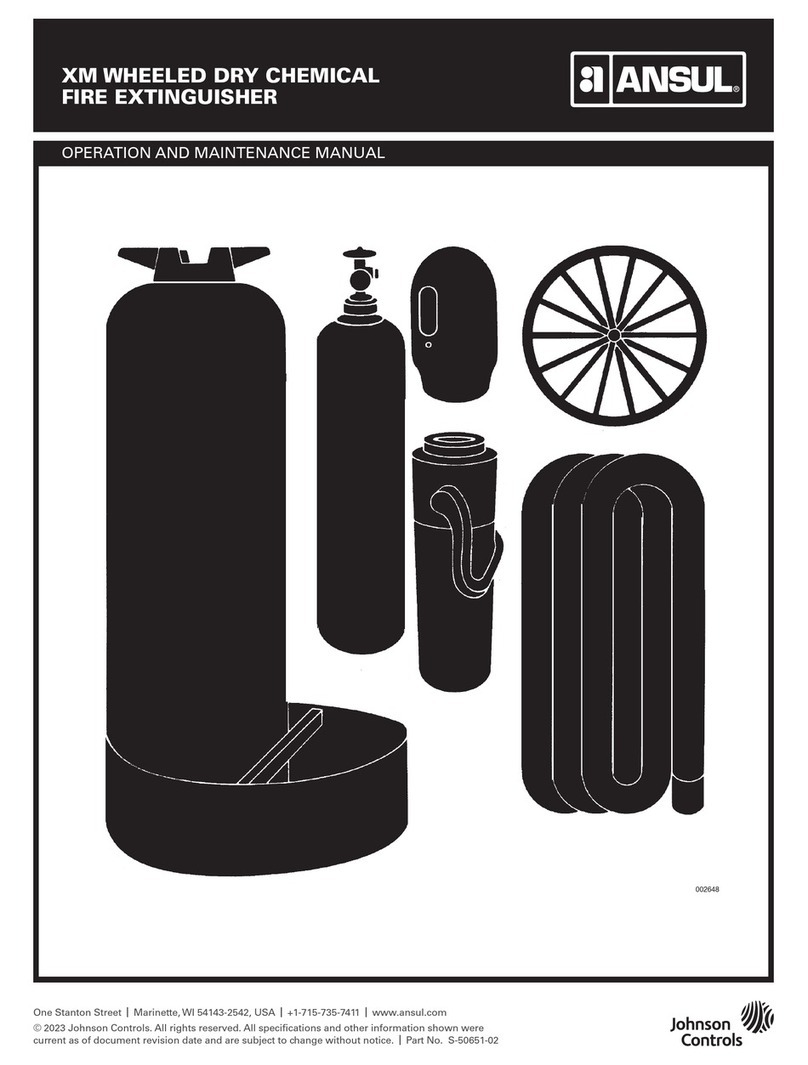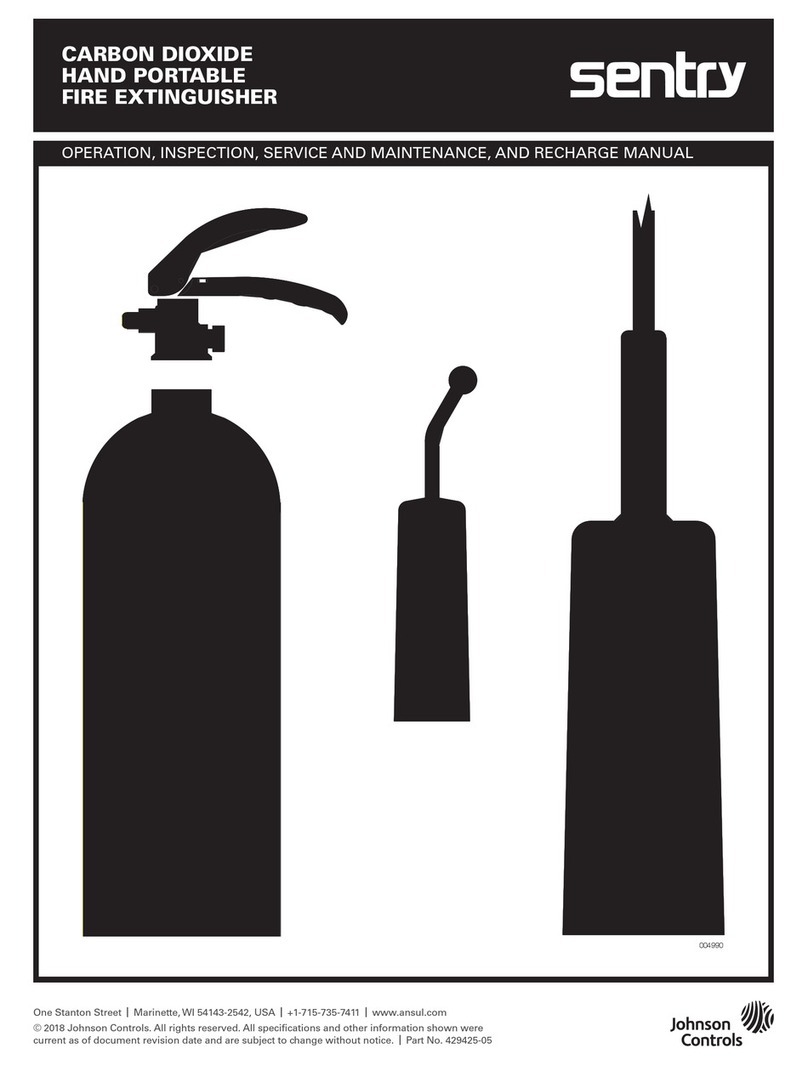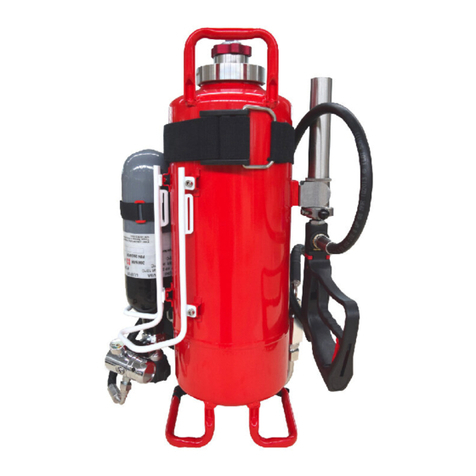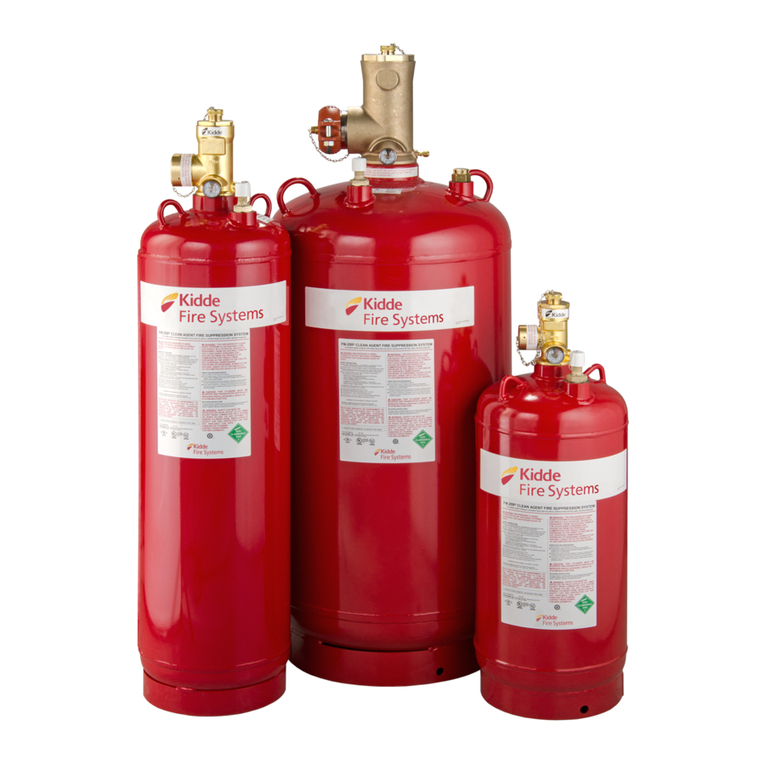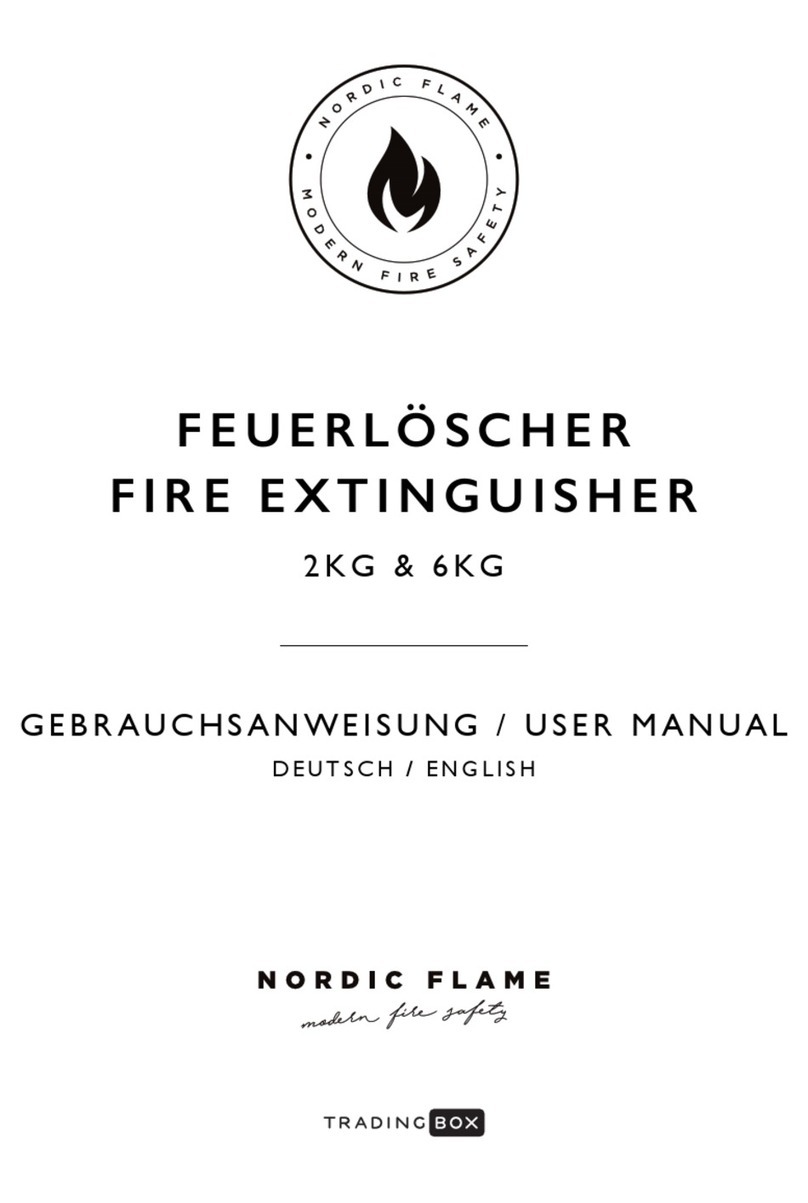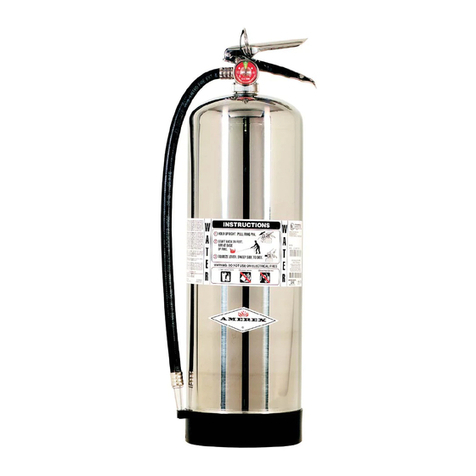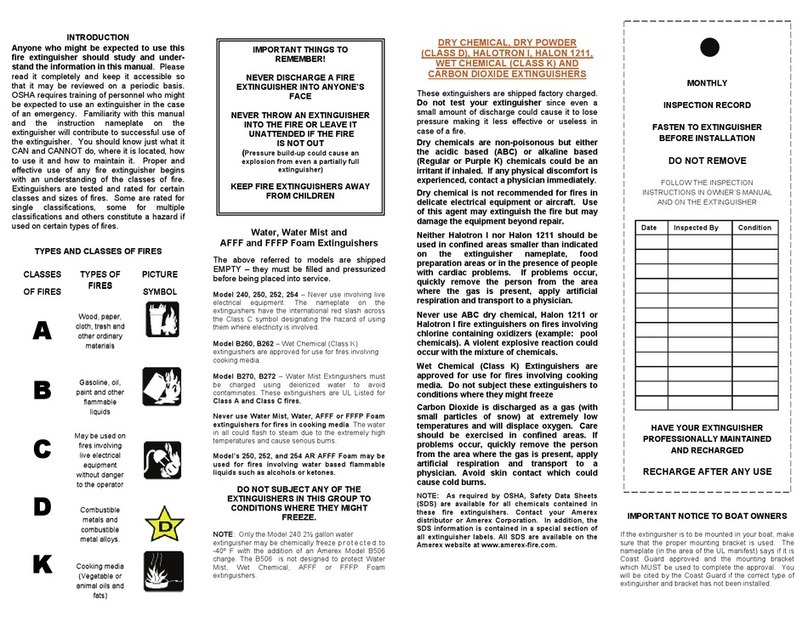Johnson Controls ANSUL 10 Installation instructions

CARTRIDGE DRY CHEMICAL
FIRE EXTINGUISHERS
MODELS 10-20-30
OPERATION, INSPECTION, SERVICE AND MAINTENANCE, AND RECHARGE MANUAL
003250
One Stanton Street |Marinette, WI 54143-2542, USA |+1-715-735-7411 |www.ansul.com
© 2018 Johnson Controls. All rights reserved. All specifications and other information shown were
current as of document revision date and are subject to change without notice. |Form No. F-7674-10


ANSUL Cartridge Dry Chemical Fire Extinguishers
Models 10, 20, 30, Operation, Inspection, Service and
Maintenance, and Recharge Manual (Form No. F-7674)
2018-OCT-15 REV. 10
FOREWORD
This manual is intended for use with the ANSUL®Models 10,
20, and 30 hand portable dry chemical extinguishers.
Those who operate, inspect, maintain, or recharge fire
extinguishers should read this entire manual. Specific
sections will be of particular interest depending upon one’s
responsibilities.
Fire extinguishers are mechanical devices. They require
periodic care. If the extinguishers are not installed properly, are
abused in service or are not properly maintained, they may not
perform reliably.
Inspection, to provide reasonable assurance your fire
extinguisher is fully charged and operable, will vary from hourly
to monthly, based on the needs of the situation. Inspections
should always be conducted at regular intervals. Maintenance,
to help provide maximum assurance the fire extinguisher will
operate effectively and safely, must be conducted annually, or
earlier when indicated by an inspection.
These extinguishers are pressure vessels that must be treated
with respect and handled with care.
Only genuine ANSUL replacement components shall be installed
on ANSUL products. Only Authorized ANSUL Distributors shall
be allowed to service and maintain ANSUL products.
This manual is limited to uses herein described. For other appli-
cations, contact your local Authorized ANSUL Distributor or
Johnson Controls – Technical Services Department, Marinette,
Wisconsin 54143-2542, USA.
Note: The converted metric values in this manual are provided
for dimensional reference only and do not reflect an actual
measurement.
Form Number: F-7674
Date: 2018-OCT-15
ANSUL, RED LINE, and the product names listed in this material are marks and/
or registered marks. Unauthorized use is strictly prohibited.

ANSUL Cartridge Dry Chemical Fire Extinguishers
Models 10, 20, 30, Operation, Inspection, Service and
Maintenance, and Recharge Manual (Form No. F-7674)
REV. 10 2018-OCT-10
EXPLANATION OF SAFETY ALERTS
p
!DANGER
Indicates a hazardous situation in which a person will
experience serious personal injury or death if the situation
is not avoided.
!WARNING
Indicates a hazardous situation in which a person could
experience serious personal injury or death if the situation
is not avoided.
!CAUTION
Indicates a hazardous situation in which a person could
experience minor or moderate personal injury if the
situation is not avoided.
CAUTION
Addresses practices not related to personal injury, such as
a system part malfunctioning, property damage, or system
failure.
NOTICE
Addresses general practices or observations
related to system function that are not related
to personal injury.

ANSUL Cartridge Dry Chemical Fire Extinguishers
Models 10, 20, 30, Operation, Inspection, Service and
Maintenance, and Recharge Manual (Form No. F-7674)
2018-OCT-15 REV. 10 PAGE TOC-1
TABLE OF CONTENTS
SECTION PAGE
Introduction 1–2
Operation 3
Inspection 5–6
Service and Repair 7-8
Maintenance 9-16
Heavy Duty/Vehicle Bracket 17-20
Bracket Introduction 17
Capabilities and Limitations 17
Bracket Installation and Mounting 18
Mounting Location 18
Inspection 19
Maintenance 19
Adjustment 20
Servicing Materials 21
Gas Tube Replacement Procedures 23
Nozzle Plunger Replacement Procedure 25-26
Cartridge Receiver Puncture Pin Replacement 27
Nameplate Replacement 29
Recharge 31–34

ANSUL Cartridge Dry Chemical Fire Extinguishers
Models 10, 20, 30, Operation, Inspection, Service and
Maintenance, and Recharge Manual (Form No. F-7674)
PAGE TOC-2 REV. 10 2018-OCT-15
TABLE OF CONTENTS
NOTES:

ANSUL Cartridge Dry Chemical Fire Extinguishers
Models 10, 20, 30, Operation, Inspection, Service and
Maintenance, and Recharge Manual (Form No. F-7674)
INTRODUCTION
2018-OCT-15 REV. 10 PAGE 1
INTRODUCTION
The Occupational Safety and Health Administration (OSHA) –
Rules and Regulations state that ‘‘the National Fire Protection
Association (NFPA) provides excellent guidelines in its
standard for portable fire extinguishers. The latest edition of
NFPA 10, Standard for Portable Fire Extinguishers is available
from the National Fire Protection Association, Batterymarch
Park, Quincy, MA 02269.
The Compressed Gas Association, Inc. Standard CGA C-6
‘‘Standard For Visual Inspection of Steel Compressed Gas
Cylinders’’ provides information on determining unacceptable
dents and corrosion. It is available from the Compressed Gas
Association, Inc., 1235 Jefferson Davis Highway, Arlington,
VA 22202.
RESPONSIBILITY
The owner or occupant of a property in which fire
extinguishers are located has an obligation for the care and
use of these extinguishers at all times. By doing so, he/
she is contributing to the protection of life and property.
The nameplates and instruction manual should be read and
thoroughly understood by all persons who may be expected to
use extinguishers.
INSPECTION
Inspection is a ‘‘quick check’’ that an extinguisher is available
and will operate. It is intended to give reasonable assurance
that the extinguisher is fully charged and operable. This is
done by seeing that the extinguisher is in its designated
place, that it has not been actuated or tampered with, and that
there is no obvious physical damage or condition to prevent
operation. The value of an inspection lies in the frequency,
regularity, and thoroughness with which it is conducted.
Extinguishers shall be inspected at regular monthly intervals,
or at more frequent intervals when circumstances require.
MAINTENANCE
Extinguishers shall be maintained at regular intervals, not
more than one year apart, or when specifically indicated by
an inspection. Maintenance is a ‘‘thorough check’’ of the
extinguisher. It is intended to give maximum assurance that
an extinguisher will operate effectively and safely. It includes
a thorough examination and any necessary repair, recharging,
or replacement. It will normally reveal if there is a need for
hydrostatic testing of an extinguisher.
RECHARGE
All extinguishers shall be recharged immediately after
use. They shall also be recharged when dictated by an
inspection or when performing maintenance. Recharge is the
replacement or replenishment of the suppressing agent. It
also includes the replenishment of the expellant for certain
types of extinguishers. When performing the recharge, use
only those materials specified on the nameplate. The use
of other recharging materials may impair the efficiency,
cause malfunction, or damage the extinguisher resulting
in possible injury to the operator.
Select a dry, warm, and preferably enclosed location with
atmospheric conditions of not more than 55% relative humidity
and ambient temperatures of not less than 65 °F (18 °C).
HYDROTEST
Extinguishers shall be hydrostatically tested at regular
intervals as required in the latest edition of NFPA 10,
Standard for Portable Fire Extinguishers, or more frequently
when inspection or maintenance indicates a specific need.
Such tests are usually required on extinguisher shells, some
cartridges, and certain hose assemblies.
IF, AT ANY TIME, AN EXTINGUISHER SHOWS
EVIDENCE OF CORROSION OR MECHANICAL DAMAGE,
THE EXTINGUISHER SHALL BE SUBJECTED TO A
HYDROSTATIC PRESSURE TEST, OR REPLACED.
!WARNING
AIR OR GAS SHOULD NOT BE USED FOR PRESSURE
TESTING AS FAILURE OF THE SHELL COULD BE VIOLENT
AND DANGEROUS.
THE EXTINGUISHER SHALL BE EMPTIED AND
HYDROSTATICALLY TESTED AT TWELVE-YEAR
INTERVALS. The test may be conducted within twelve months
of the specified interval.
WELDING/BRAZING
Field repair of ANSUL cartridge-operated hand portable
extinguishers is allowed only if the repairs are made in accor-
dance with good silver brazing practices and the following
restrictions:
–Repairs shall be made by means of silver brazing only.
–Silver brazing is restricted to the carrying handle lug,
nozzle holster nuts, hanger attachment, and the visual seal
attachment.
–Repairs MAY NOT BE MADE TO THE SHELL ITSELF.
Thus, if the mild steel shell is damaged as by tearing of
the parent metal from the shell, the extinguisher must be
discarded.
–After completion of repairs, the extinguisher shall be hydro-
statically tested in accordance with the ANSUL Hydrostatic
Test Instruction Manual (Form No. F-7602, latest revision).
RECORD KEEPING
Each extinguisher shall have a tag or label securely attached
that indicates the month and year the maintenance was
performed and shall identify the person performing the
service. The record or tag shall indicate if recharging was
also performed. At least monthly, the date the inspection was
performed and initials of the person performing the inspection
shall be recorded.

ANSUL Cartridge Dry Chemical Fire Extinguishers
Models 10, 20, 30, Operation, Inspection, Service and
Maintenance, and Recharge Manual (Form No. F-7674)
INTRODUCTION
PAGE 2 REV. 10 2018-OCT-15
RECORD KEEPING (Continued)
A separate label shall also be affixed to the extinguisher
following a successful hydrostatic test. This label shall include
the month and year the test was performed, the test pressure
used, and the name or initials of the person performing the
test. This label shall be self-destructive when removal from the
extinguisher is attempted.
In addition to the required tags or labels, a permanent file
record should be kept for each extinguisher. This file record
should include the maintenance date and the name of the
person performing the maintenance, the date when last
recharged and the name of the person or agency performing
the hydrostatic test, and a description of the extinguisher’s
physical condition after passing a hydrostatic test.
Parts of above were taken from the latest edition of NFPA 10,
Standard for Portable Fire Extinguishers.
PARTS LISTS
To order parts lists, contact Johnson Controls Customer
Services, Marinette, WI 54143-2542.
REFERENCES
REFERENCES IN THIS MANUAL: AVAILABLE FROM:
NFPA-10 “STANDARD FOR NFPA
PORTABLE FIRE 1 Batterymarch Park
EXTINGUISHERS” Quincy, MA 02169-7471
CGA C-1 “METHODS FOR Compressed Gas
HYDROSTATIC Association
TESTING OF 14501 George
COMPRESSED Carter Way, Suite 103
GAS CYLINDERS” Chantilly, VA 20151-1788
CGA C-6 “STANDARD FOR
VISUAL INSPECTION
OF STEEL
COMPRESSED
GAS CYLINDERS”

ANSUL Cartridge Dry Chemical Fire Extinguishers
Models 10, 20, 30, Operation, Inspection, Service and
Maintenance, and Recharge Manual (Form No. F-7674)
2018-OCT-15 REV. 10 PAGE 3
OPERATION
OPERATION
To Operate The Extinguisher:
1. Remove the extinguisher from its station.
2. Use the handle to carry the extinguisher to the fire. Walk
at a rapid pace. DO NOT RUN.
3. Proceed to the upwind side of the fire. Stay well clear of
the flames. From this position, the air currents help carry
the agent into the fire, assures maximum visibility and
provides protection from the heat.
4. Start back from fire at a distance recommended on
extinguisher nameplate. Remove the nozzle from its
holder and pull the hose free from behind the puncture
lever. Then take a firm grip on the nozzle and ‘‘push’’
the puncture lever down firmly. The puncture lever must
be depressed to become almost flush with the top of the
cartridge guard to assure full penetration of the cartridge
disc by the puncture pin. If the extinguisher employs a
ring pin, pull the ring pin before any attempt to operate
the puncture lever.
NOTICE
For additional information on the proper
use and suppression applications of ANSUL
cartridge operated extinguishers, we offer
hands-on fire fighting training at the ANSUL
fire school. Visit www.ansul.com.
2 003169
1 003168
4 0031713 003170

ANSUL Cartridge Dry Chemical Fire Extinguishers
Models 10, 20, 30, Operation, Inspection, Service and
Maintenance, and Recharge Manual (Form No. F-7674)
PAGE 4 REV. 10 2018-OCT-15
OPERATION
NOTES:

ANSUL Cartridge Dry Chemical Fire Extinguishers
Models 10, 20, 30, Operation, Inspection, Service and
Maintenance, and Recharge Manual (Form No. F-7674)
2018-OCT-15 REV. 10 PAGE 5
INSPECTION
INSPECTION
Where an inspection reveals that tampering has occurred
or that the extinguisher is damaged, impaired, leaking
or has obvious corrosion, complete maintenance as
described on pages 9 through 16 should be followed.
To provide reasonable assurance extinguisher is charged
and operable:
1. Make certain the extinguisher is in its designated place,
is clearly visible and is accessible for immediate use.
Any obstructions that obscure it, or that would otherwise
impair its being readily accessible, should be removed.
2. Check the visual seal on the cartridge receiver and,
if provided, the tamper-proof seal on the fill cap. The
absence of a seal or a broken seal may indicate either
unreported use or tampering. In either case, a complete
maintenance check is required.
3. Ansul indicator fill cap models, in addition to a visual seal,
feature a red stem indicator which pops up in the center
of the fill cap and remains up after the pressure has been
relieved. Check the red indicator stem. If up, a complete
maintenance check is in order.
4. Remove the extinguisher from its mounting bracket and
heft (lift up and down slightly) to determine if it is filled.
5. Examine the extinguisher shell, cartridge guard, cartridge
receiver and all other external parts for evidence of physi-
cal damage, corrosion or other impairments.
6. Check the nameplate for readability – especially the oper-
ating instructions. If they are not legible, an instructed (but
not necessarily trained) person may not understand the
method of operation in the excitement created by a fire.
1 003189 2003190
3 003191 4003192
5 003193 6003194

ANSUL Cartridge Dry Chemical Fire Extinguishers
Models 10, 20, 30, Operation, Inspection, Service and
Maintenance, and Recharge Manual (Form No. F-7674)
PAGE 6 REV. 10 2018-OCT-15
INSPECTION
INSPECTION (Continued)
7. Examine the hose for cuts, severe weather checking,
abrasion or deformed exterior. Depending upon the
severity of the disorder, the hose could rupture upon
pressurization of the extinguisher.
8. Check the hose couplings for tightness, corrosion or
cracks. A loose connection of coupling to shell outlet
or nozzle could contribute to a significant change in
discharge characteristics upon use. A corroded or
cracked coupling could separate under pressure.
9. Check the nozzle tip and handle for obvious damage or
obstructions. Insects are common causes of obstructions
particularly in the warmer climates.
10. Secure the nozzle back into its holder and ensure visual
seal, and, if provided, the tamper-proof seal, are intact.
11. If the extinguisher is wall hung, verify that the support is
able to hold the extinguisher safely. If a vehicle bracket
or a heavy duty vehicle bracket is used, refer to pages
17-20. Return extinguisher to its designated location.
12. Personnel making inspections are usually required to
keep records by way of marking a tag attached or affixed
to the extinguisher and/or in a permanent file. Your
precise guide to record keeping requirements should be
the applicable company, local, state or federal authority
having jurisdiction.
8 0031967 003195
9 003197 10 003198
11 003199 12 003200

ANSUL Cartridge Dry Chemical Fire Extinguishers
Models 10, 20, 30, Operation, Inspection, Service and
Maintenance, and Recharge Manual (Form No. F-7674)
2018-OCT-15 REV. 10 PAGE 7
SERVICE AND REPAIR
SERVICE AND REPAIR
The best assurance against fire extinguisher malfunction is proper operation, recharge, inspection and maintenance. To
remedy any disorder detected through periodic inspection or maintenance examinations, the following table lists some
of the possible irregularities that may develop and gives suggestions for corrective action.
COMPONENT DISORDER CORRECTIVE ACTION
Suppressing Dents* or abrasions Hydrostatically test (see Hydrostatic Test Instructions,
Agent Shell Form No. F-7602, latest revision) and refinish (clean damaged
area and repaint) or replace extinguisher.
Rust spots, pits and corrosion deposits Clean corroded areas, and repaint, replacing tank if there is any
corrosion penetration.
Threads nicked, cross-threaded, Clean threads with a stiff bristle brush. Small nicks or burrs
corroded or worn may be eliminated by careful re-tapping. If damaged or worn
extensively, the extinguisher should be replaced.
Fill opening gasket seating surface nicked, Clean seating surface and lubricate the surface lightly with a
gouged, corroded or bearing dirt deposits good grade of high heat resistant grease. If surface is sharply
nicked or deeply gouged, replace extinguisher.
Obstructed pressure vent hole in fill Clear vent hole with a stiff, unbreakable wire probe of lesser
opening threads diameter than vent hole.
Seam welds evidencing discoloration or Consult Johnson Controls,
pin holes Marinette, Wisconsin 54143-2542.
Fill Cap Abraded, cracked, corroded or otherwise Replace, destroying affected cap to prevent reuse.
damaged fill cap
Threads corroded, nicked, cross-threaded or Replace, destroying affected cap to prevent reuse.
worn
Cut, checked, deformed, stiff, brittle or Replace, lubricate new gasket lightly.
worn gasket or quad ring
Plastic indicator housing cap cracked or Replace plastic cap.
missing
Indicator stem immovable or stiff operating Disassemble and clean, replacing parts as required.
Suppressing Improper fill level Fill shell to rated capacity with ANSUL suppressing agent
Agent specified on nameplate.
**Caked dry chemical Discard agent and refill clean tank to rated capacity with ANSUL
suppressing agent specified on nameplate.
Gas Tube Bent, cracked, broken or obstructed Replace, using factory built and pressure tested assembly only.
See page 23.
Cut, loose, leaking, damaged, or missing check Replace, using factory built and pressure tested assembly only.
valve See page 23.
Nameplate Unreadable wording Use a mild abrasive (scouring powder) to clean plate. If
readability cannot be improved, replace operating nameplate.
Loose Inspect area under plate.*** If corroded, see “Suppressing Agent
Shell – Rust spots, pits and corrosion deposits’’ and re-affix
nameplate using a good grade of heatless adhesive.
Missing Replace with correct nameplate.***
Expellant Gas Rust spots, pits and corrosion deposits Clean corroded areas and repaint or replace cartridge if there is
Cartridge any corrosion penetration.
Dents or abrasions De-pressurize, remove seal and destroy both internal and
external threads on the cartridge to render the vessel unusable.
Threads on cartridge nicked, cross- The cartridge should be replaced and properly scrapped.
threaded, corroded or worn
Dry Chemical on Cartridge Seal Replace Gas Tube.
* Refer to Compressed Gas Association (CGA) Pamphlet C-6.
** The term caked, as applied to dry chemical describes a specific condition that is best identified as dry chemical containing hard lumps. These lumps will render
a dry chemical extinguisher inoperative. The condition usually follows the absorption and later the evaporation of an unusual amount of moisture. It is often
confused with ‘‘packing’’ (a condition produced by normal settling, by vibration or impact.) A simple procedure to determine which condition exists is the UL test
in which lumps are dropped from 4 in. (102 mm) onto a clean hard surface. if the lumps do not break up into individual particles, caking is present. For additional
details, refer to ANSUL Technical Bulletin Caking Versus Packing of Dry Chemical Agents (Form No. F-8083, latest revision).
*** Replacement maintenance nameplates will not have U.L. manifest.

ANSUL Cartridge Dry Chemical Fire Extinguishers
Models 10, 20, 30, Operation, Inspection, Service and
Maintenance, and Recharge Manual (Form No. F-7674)
PAGE 8 REV. 10 2018-OCT-15
SERVICE AND REPAIR
SERVICE AND REPAIR (Continued)
COMPONENT DISORDER CORRECTIVE ACTION
Cartridge Guard Rust spots, pits or corrosion deposits Replace guard or clean corroded areas and repaint.
Dents or abrasions Repair and refinish; or replace guard.
Paint peeling Remove loose paint with a wire brush and repaint or replace
guard.
Broken clip attachment Drill tw Refer to Parts List. o 3/16 in. holes in location of existing
composite weld pins. Pop rivet clip into guard using 3/16 in.
stainless steel pop rivets.
Cartridge Receiver Bent, binding, corroded or dull puncture pin Replace puncture pin. See page 27.
Obstructed pressure vent hole Clear vent hole with a stiff, unbreakable wire probe of lesser
diameter than vent hole.
Threads corroded, nicked, cross- Replace cartridge receiver destroying affected receiver to
threaded or worn prevent reuse. See page 23.
Hose Cut, cracked, abraded or deformed exterior Replace entire hose assembly.
Corroded or cracked coupling, swivel Replace entire hose assembly.
joint or ferrule
Corroded, cross-threaded or worn Replace entire hose assembly.
coupling threads
Internal blockage Clear by flexing or blowing dry air or nitrogen through the hose
at 50 psi (3.45 bar).
!CAUTION
Do not leave open end of hose unattended unless adequately
restrained to prevent whipping, endangering life/safety.
Coupling O-ring, brittle, compression Replace, lubricating new o-ring lightly.
set, cracked, cut or missing
Nozzle Wrong nozzle Replace with proper model nozzle recommended by Johnson
Controls. Refer to Parts List.
Nozzle body corroded, cracked or dented Replace nozzle.
Operating handle broken or deformed Replace handle.
Operating handle binding or immovable See ‘‘Leaking Nozzle’’ below.
Leaking nozzle, plugged tip and/or Disassemble and clean deposits from internal passages and
discharge passage parts with a small, stiff bristle brush; examine internal parts
and replace if cut, checked, deformed, stiff, brittle or worn.
Reassemble nozzle and pressure test at 250 psi (17.24 bar).
Threads nicked, worn or cross-threaded Replace nozzle.
Gaskets brittle, compression set, cracked, Replace, lubricating gasket lightly.
cut or missing
Plunger tip evidencing cuts, abrasions, Replace.
degrading rubber, brittleness, or
separation from plunger NOTICE
All old, molded rubber plunger type tips
(without screw) should be replaced during
maintenance with the captured style tip.
See page 25.

ANSUL Cartridge Dry Chemical Fire Extinguishers
Models 10, 20, 30, Operation, Inspection, Service and
Maintenance, and Recharge Manual (Form No. F-7674)
2018-OCT-15 REV. 10 PAGE 9
MAINTENANCE
MAINTENANCE
If a questionable condition exists, refer to Service and
Repair. Become familiar with the Service and Repair
section prior to performing maintenance.
To provide maximum assurance extinguisher will operate
effectively and safely, maintenance must be conducted
annually or when specifically indicated by an inspection.
NOTICE
Always be alert for any indications of damage
or in-operability in the unit. No manual can
anticipate everything that could happen to a
unit. In the event that something not covered
in the manual is found, ascertain whether
any potential for damage exists and repair or
replace, as necessary.
1. Make certain the extinguisher is in its designated
place, conspicuous, readily accessible and immediately
available in the event of fire.
2. Remove the extinguisher from its wall hanger or bracket.
Check the securement of the hanger or bracket. See
page 19 for maintenance of the extinguisher bracket. A
loose hanger or bracket could lead to loss of the extin-
guisher with resultant harm to the extinguisher and/or
people in the vicinity.
NOTICE
Extinguishers out of service for maintenance
or recharge shall be replaced by spare extin-
guishers of the same type and at least equal
rating.
3. Check the date of manufacture stamped on the shell or
the date of last hydrostatic test on the label affixed to the
extinguisher to make certain it does not exceed the test
interval (twelve years) specified in the latest edition of
NFPA 10, Standard for Portable Fire Extinguishers.
4. Invert the extinguisher and open the nozzle to ensure that
any pressure is relieved from the shell.
5. Return extinguisher to the upright position, place the hose
in its normal position and insert the nozzle in the holder.
6. Examine the dry chemical shell and all other external
components for evidence of corrosion, mechanical
damage, or the presence of welding, soldering or brazing
repairs other than as allowed by Johnson Controls. (See
Introduction, page 1, of this manual for welding/brazing
restrictions.) Depending on the degree of corrosion,
extent of mechanical damage, or type of repair, the extin-
guisher may constitute a potential hazard to persons in
its vicinity, to operators, or service personnel; and may
require replacement or hydrostatic test.
1 003189 2 003168
3 003201 4 003198
5 003196 6 003193

ANSUL Cartridge Dry Chemical Fire Extinguishers
Models 10, 20, 30, Operation, Inspection, Service and
Maintenance, and Recharge Manual (Form No. F-7674)
PAGE 10 REV. 10 2018-OCT-15
MAINTENANCE
MAINTENANCE (Continued)
7. Check the nameplates for legibility, looseness or corro-
sion. If the wording is illegible, the nameplate must be
cleaned or replaced. A loose nameplate must be removed
for examination of the area under the plate. If corroded,
take appropriate corrective action as the surface condition
would indicate, meaning clean and repaint, hydrostatic
test and then re-affix the nameplate using a good grade
of heatless adhesive or replace extinguisher if necessary.
8. Remove cartridge guard and check integral inside compo-
nents for mechanical damage or evidence of corrosion.
“E” Models (Metal cartridge guard) – Pull the guard
straight out from the side of the extinguisher.
“G” Models (Composite cartridge guard) – To remove
the composite cartridge guard, remove the nozzle from
the nozzle retainer, lift the hose out from behind the punc-
ture lever, (it will be necessary to break the visual seal),
pull on the upper portion of the guard until it releases
from the cartridge, and then pull up until the bottom fork
of the guard clears the discharge elbow.
9. Unscrew the cartridge (turn in direction of arrow on
cartridge) to examine seal. Ensure that it has not been
punctured and it is the proper ANSUL cartridge and has
the proper ANSUL seal. A spent or used cartridge is
readily identifiable from a full cartridge by the large hole in
the seal, made by the puncture pin upon operation of the
extinguisher.
10. Weigh the cartridge. If weight is 1/4 oz (7.1 g) for Model
10 or 1/2 oz (14.2 g) for Models 20/30 less than stamped
on the cartridge, replace with full cartridge. Cartridges
which weigh more than 1/4 oz (7.1 g) over stamped
weight should also be replaced.
!CAUTION
Do not return cartridge to receiver at this time. Failure to
comply could result in personal injury or property damage
due to violent cartridge movement or premature extin-
guisher pressurization.
11. Install safety shipping cap (Part No. 77250 for left-hand
and 77251 for right-hand threaded cartridges) onto
cartridge at this time.
!CAUTION
Cartridge safety shipping caps must always be installed
whenever cartridge is removed from receiver (except
while weighing). If shipping cap is not installed, and seal
ruptures due to damage or high temperature, the cartridge
could become a projectile causing possible personal
injury or property damage.
12. Remove nozzle from its holder and lift hose out from
behind and under the puncture lever, breaking the visual
seal, and, if provided, the tamper-proof seal, at this time.
Note: On extinguishers with the composite guard, the
seals will already have been removed and the hose will
be out from behind the puncture lever.
7 000904 8 003185
10 0032039 003202
12 00320511 003204

ANSUL Cartridge Dry Chemical Fire Extinguishers
Models 10, 20, 30, Operation, Inspection, Service and
Maintenance, and Recharge Manual (Form No. F-7674)
2018-OCT-15 REV. 10 PAGE 11
MAINTENANCE
MAINTENANCE (Continued)
13. Operate the puncture lever to make sure the lever works
freely. Inspect the cutting edge for sharpness. A bent
or dull puncture pin could hang up and not puncture
the cartridge seal disc cleanly. (See Service and Repair
Section for pin replacement.)
14. Check the pressure relief vent in the cartridge receiver
for obstruction. This relief vent may be a small hole in the
receiver collar, or a set of grooves in the threads. The
pressure relief vent provides an audible signal and a safe
vent if a cartridge is unscrewed while there is still pres-
sure inside. A stiff wire or a bristle brush may be used for
cleaning.
15. Remove and examine gasket in the cartridge receiver.
Replace if brittle, compression set, cracked, cut or
missing. Lightly lubricate with a good grade of silicone
grease or equivalent and reinstall.
16. Make sure the extinguisher shell does not contain any
pressure by slowly loosening the fill cap approximately
3-4 turns. If the extinguisher contains any pressure, it
will be relieved through the relief grooves in the cap.
Re-tighten the fill cap, until flat gasket makes contact with
the cover.
17. Carefully examine the hose assembly. A cut, cracked,
abraded or deformed exterior may constitute a potential
rupture upon pressurization and require replacement.
18. Check the hose couplings. Corroded or cracked
couplings, cross-threaded or worn threads dictate
replacement.
14 00318213 000910
15 003206 16 003175
17 003207 18 003252

ANSUL Cartridge Dry Chemical Fire Extinguishers
Models 10, 20, 30, Operation, Inspection, Service and
Maintenance, and Recharge Manual (Form No. F-7674)
PAGE 12 REV. 10 2018-OCT-15
MAINTENANCE
MAINTENANCE (Continued)
19. Operate the nozzle handle to check for free movement. If
handle is binding or immovable, refer to ‘‘Nozzle(s)’’ in the
Service and Repair Section of this manual for corrective
action.
20. Unscrew the nozzle tip while squeezing the nozzle
handle. Ensure that it is the proper nozzle tip for that
particular model by referring to the extinguisher parts list.
Remove any obstructions from nozzle tip and discharge
outlet. Make certain o-ring and/or flat gasket is in place
and is not damaged.
21. Inspect plunger tip inside nozzle body. Replace if tip
shows evidence of cuts, abrasions, degraded rubber, brit-
tleness, or separation from plunger.
NOTICE
All molded rubber style tips should be
replaced and upgraded with the captured
style tips. See page 25.
22. Apply a thin coating of thread lubricant to the nozzle tip
threads. Wipe away from the interior of the tip before
threading into nozzle. Operate nozzle handle to ensure
free movement of plunger assembly. Squeeze the nozzle
handle and thread the nozzle tip into nozzle body. Screw
the nozzle tip until it seats against the plunger. Depress
the handle and continue to turn clockwise for 1/2 to 3/4
turn.
20 00320919 003208
22 00321121 003210

ANSUL Cartridge Dry Chemical Fire Extinguishers
Models 10, 20, 30, Operation, Inspection, Service and
Maintenance, and Recharge Manual (Form No. F-7674)
2018-OCT-15 REV. 10 PAGE 13
MAINTENANCE
MAINTENANCE (Continued)
23. To check the hose for internal blockage, place the extin-
guisher on its side, with the outlet elbow in the up posi-
tion, and remove the hose. Note: If the hose contains a
hose seal, remove retaining ring and seal before running
pressure through hose as described in Step 24. With a
very small, flat bladed screwdriver, (approximately the
size used for eye glass screws), pry the retaining ring out
of the groove in the hose coupling. There is a small
cutout area in one end of the retaining ring for this
purpose. The ring can be prevented from flying out of the
groove by placing your thumb over a portion of the inlet
end of the hose during removal. Remove the retaining
ring and the metal bordered hose seal. Both can be
reused if they have not been damaged.
!CAUTION
Before proceeding with removal of seal and retaining
ring, make certain eyes are protected with proper safety
glasses. Retaining ring can pop out during removal and fly
several feet causing eye injury.
24. Squeeze the operating nozzle handle and blow dry air or
nitrogen back through the nozzle.
!CAUTION
Do not leave open end of hose unattended unless
adequately restrained to prevent whipping, endangering
life/safety. Use a regulated pressure source set to less
than 50 psi (3.45 bar). If the hose is obstructed, manipu-
late (flex) hose manually until free of dry chemical.
25. Examine the o-ring on the hose coupling. Replace if
brittle, cracked, cut or missing.
26. Ensure the extinguisher elbow is free of dry chemical
and then reinstall the hose to the elbow. Wrench tighten.
Note: If extinguisher contains a hose seal, install seal at
this time by following the procedures listed below.
a. Place a new hose seal in end of hose.
b. Place a new retaining ring (or reuse old one) on the
hose coupling and press it into the retaining ring
groove. The easiest way to do this is start the side
of the retaining ring opposite the gap in the ring into
groove and work the ring into the hose coupling
groove with both thumbnails.
c. Recheck the new hose seal to make certain it has not
been ruptured during installation.
d. Reinstall hose on extinguisher.
23 003212 24 003213
25 003214 26 003215

ANSUL Cartridge Dry Chemical Fire Extinguishers
Models 10, 20, 30, Operation, Inspection, Service and
Maintenance, and Recharge Manual (Form No. F-7674)
PAGE 14 REV. 10 2018-OCT-15
MAINTENANCE
MAINTENANCE (Continued)
27. Return the extinguisher to the upright position, remove
the fill cap, examine the fill opening threads for nicks,
cross-threading, corrosion or wear; and check the gasket
seating surface for nicks, gouges, corrosion or dirt depos-
its. Then, check the pressure relief vent for obstruction.
(The pressure relief vent may be a small hole or a set of
grooves in the collar. One of either type of pressure relief
vents must be present in each extinguisher.)
NOTICE
Normal Johnson Controls maintenance
procedures do not require the removal of
dry chemical from the cartridge operated
extinguishers, however, some states
require that the dry chemical be removed,
examined and returned to the extin-
guisher on an annual basis.
28. If the dry chemical agent is removed from the extin-
guisher, maintenance personnel should then visually
examine the gas tube and rubber sleeves for discrepan-
cies through the fill cap opening. If cracked, damaged, or
missing, a new gas tube assembly should be installed. (If
internal tagging is required, it is recommended that it be
attached to the upper portion of the gas tube.)
29. Once the dry chemical has settled, make certain the tank
is filled to rated capacity indicated on the nameplate. (An
approximate visual indication of 1 in. to 3 in. (25 mm to 76
mm) from the bottom of fill opening is acceptable.) Ensure
that the extinguisher is filled with free-flowing ANSUL dry
chemical of the type specified on the extinguisher name-
plate.
30. Remove the flat gasket and quad ring from the fill cap.
Then thoroughly clean the fill cap threads and gasket
seating surface with a stiff bristle brush. (If the fill cap
has pressure relief vent grooves, be sure they are unob-
structed.)
31. Examine the fill cap for abrasions, cracks or corrosion
and the fill cap threads for nicks, burrs, cross-threading,
rough or feathered edges. If the fill cap is the ANSUL
indicator type, grasp the indicator stem and gently move
the stem up and down to check for free movement. Refer
to the ‘‘Fill Cap’’ Service Instructions in the Service and
Repair Section of this manual for corrective action.
32. Examine the fill cap gasket and quad ring for cuts,
checks, deformities and wear and then stretch them to
determine elasticity.
28 00321727 003216
30 003179a29 003218
32 00326331 003219
This manual suits for next models
2
Table of contents
Other Johnson Controls Fire Extinguisher manuals
